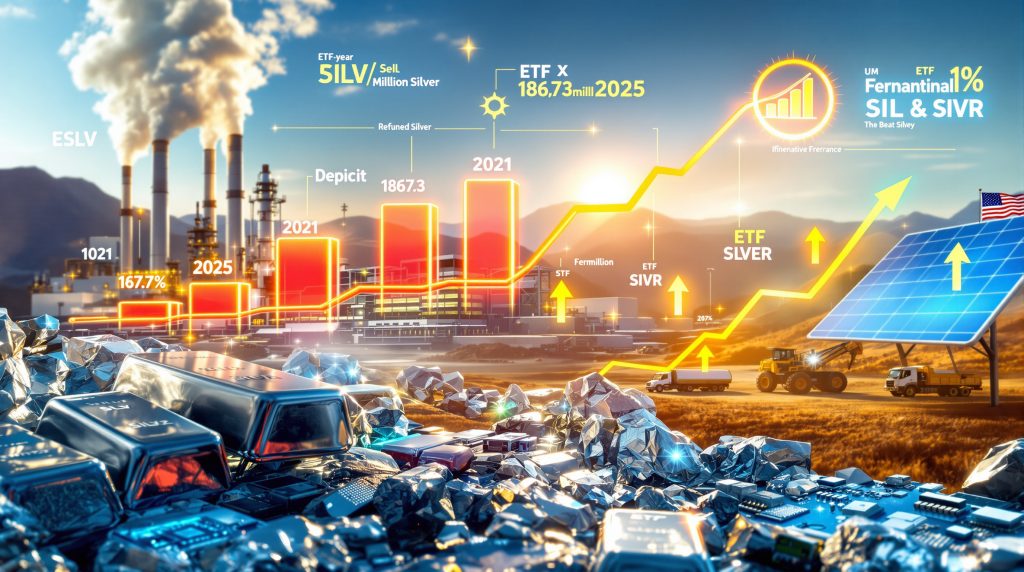Refined silver shortages represent a critical disruption in global precious metals markets, where processed, investment-grade silver fails to meet escalating demand across industrial, monetary, and investment sectors. Unlike raw silver ore availability, these shortages specifically impact deliverable metal quality suitable for manufacturing electronics, solar panels, and financial market transactions.
The refined silver supply chain operates through an intricate network of mining operations, processing facilities, and distribution channels. When bottlenecks emerge at refining stages, even adequate raw silver production cannot satisfy end-user requirements for high-purity metal meeting London Good Delivery standards of 999.0 parts per thousand fine silver.
Understanding Refined Silver Market Dynamics
Investment-grade silver must undergo multiple processing stages including primary smelting, electrorefining, and granulation before reaching market-ready specifications. Each stage presents potential constraints that can amplify supply shortages even when mining output appears sufficient.
The distinction between "paper silver" traded through futures contracts and physical refined silver available for delivery has become increasingly important. Financial markets may show adequate paper supply while physical inventories remain critically constrained, creating pricing disconnects that drive market volatility. These dynamics are further explored in our comprehensive silver market squeeze insights.
Critical Supply Chain Vulnerabilities
The 2025 silver squeeze analysis reveals unprecedented multi-year supply-demand imbalances. Furthermore, the refined silver shortage represents an escalation from consecutive annual deficits that have depleted global inventories systematically.
According to the Silver Institute's World Silver Survey 2024, the market experienced a supply deficit of 184.3 million ounces in 2023, representing the second consecutive year of deficit conditions.
Historical Context and Current Deficit Analysis
Historical data reveals accelerating deficit conditions across multiple years:
- 2022: Supply deficit of 142.1 million ounces
- 2023: Deficit expanded to 184.3 million ounces
- COMEX warehouse stocks: Declined from 356 million ounces in January 2021 to 264 million ounces by December 2023 (26% decline)
Important Note: Future projections beyond verified historical data should be considered speculative estimates rather than confirmed market data.
Five-Year Trajectory Analysis
Above-ground silver inventories function as critical buffers during deficit periods, with both visible stocks at exchanges and invisible private holdings providing market stability. The London Bullion Market Association reported silver vault holdings of approximately 1.09 billion ounces as of December 2023. However, accessibility of these reserves varies significantly based on contractual obligations and storage agreements.
Supply deficits are calculated using the methodology: Total Fabrication Demand + Net Physical Investment – Mine Production – Recycling – Net Producer Hedging, providing standardised measurement across industry reporting. Additionally, understanding tariff impacts on silver prices becomes crucial when assessing global market dynamics.
Inventory Depletion Mechanisms
The structural nature of refined silver shortages differs fundamentally from cyclical market adjustments. Consequently, these shortages reflect persistent demand growth outpacing available supply additions across multiple consecutive years.
Industrial Demand Transformation
Industrial silver consumption has fundamentally shifted from cyclical manufacturing applications to structural, technology-driven requirements exhibiting minimal price elasticity. This transformation reflects silver's unique physical properties that cannot be easily substituted in critical applications.
Solar Photovoltaic Revolution
Solar photovoltaic applications have emerged as the dominant growth driver in industrial silver demand. According to Silver Institute data:
- 2021: 130 million ounces consumed
- 2022: 140 million ounces consumed
- 2023: 161 million ounces consumed (15% year-over-year increase)
Silver's electrical conductivity of 63.0 × 10⁶ S/m at 20°C represents the highest of all metals, making it essential for maximising photovoltaic cell efficiency. Substitution efforts using copper have resulted in 5-10% efficiency losses, demonstrating the critical nature of silver in renewable energy infrastructure.
Key Solar Demand Catalysts:
- Government renewable energy mandates under Net Zero policies
- Declining solar installation costs accelerating adoption rates
- Grid-scale solar projects requiring substantial silver inputs
- Residential solar expansion across emerging markets
Electric Vehicle and Electronics Expansion
Beyond solar applications, silver demand continues expanding across multiple technology sectors. For instance, understanding broader silver pricing strategies becomes essential for investors navigating these market shifts.
Electric Vehicle Integration:
- Average battery electric vehicles contain 25-50 grams of silver
- Global EV sales reached 13.6 million units in 2023 (16% of total auto sales)
- Each vehicle requires silver in electrical contacts, battery management systems, and charging infrastructure
5G Network Infrastructure:
- GSMA reported 1.7 billion 5G connections globally by end of 2023
- Each 5G base station requires 3-5 times more silver than 4G due to antenna complexity
- Projected growth to 5.3 billion connections by 2030
Medical and Specialised Applications:
- Silver's antimicrobial properties documented against 650+ disease-causing organisms
- Water purification systems increasingly utilising silver-based technologies
- RFID and IoT sensors requiring high-conductivity materials
Physical Market Stress Indicators
Extreme conditions in physical silver markets have manifested through unprecedented lease rate spikes and delivery constraints, signalling acute scarcity of deliverable metal in over-the-counter markets. Furthermore, these conditions reflect underlying structural imbalances rather than temporary liquidity disruptions.
Lease Rate Mechanics and Historical Context
Silver lease rates represent the cost of borrowing physical metal for short-term delivery obligations. Normal rates typically range between 0.25% and 2% annually during equilibrium conditions. Historical precedent shows lease rates briefly exceeded 20% during the 2011 silver price spike as physical tightness emerged.
Lease Rate Calculation:
- Lease Rate = GOFO (Gold Forward Offered Rate) – SIFO (Silver Forward Offered Rate)
- Rates above 10% indicate severe market stress
- Sustained elevated rates suggest structural supply constraints
Additionally, gold-silver ratio insights provide valuable context for understanding precious metals market dynamics during stress periods.
Backwardation and Market Structure
The silver market experiences backwardation when spot prices exceed futures prices, indicating immediate supply scarcity outweighing future delivery expectations. This unusual condition for storable commodities typically signals severe market stress and can sustain elevated price levels for extended periods.
Backwardation interacts with the gold-silver ratio during stress periods, as both metals compete for safe-haven capital while exhibiting different supply-demand dynamics. However, refined silver shortages create unique market conditions distinct from general precious metals volatility.
Refining Capacity Constraints
Refining bottlenecks have emerged as critical limitations preventing adequate transformation of raw silver into investment-grade metal suitable for industrial and financial applications. Global silver refining capacity approximates 1.3 billion ounces annually across roughly 40 major refineries worldwide.
Geographic Concentration Risks
Regional Distribution:
- Mexico, Peru, and China account for approximately 60% of global silver refining capacity
- European refineries suspended silver scrap intake during 2022-2023 energy crisis
- Germany's Aurubis AG reduced throughput by 15% in 2022 due to natural gas price increases
Operational Cost Pressures
Energy and Compliance Costs:
- Energy costs represent 25-35% of total silver refining operating expenses
- Environmental compliance costs increased 40-60% since 2015
- Stricter emissions regulations requiring capital investments in processing equipment
Scrap Processing Limitations:
Several European refineries suspended silver scrap acceptance due to elevated processing costs and financing constraints during the energy crisis, reducing recycled silver availability and increasing dependence on primary mine production. Consequently, this created additional pressure on already constrained refined silver markets.
Infrastructure Development Timelines
Expanding refining capacity requires substantial capital investment and extended development periods. New refining infrastructure typically requires 3-5 years for planning, permitting, and construction, creating supply response lags that cannot quickly address immediate shortage conditions.
Moreover, refined silver shortages cannot be resolved through short-term operational adjustments, requiring systematic capacity expansion across multiple facilities and jurisdictions.
Monetary Policy Impact Mechanisms
Federal Reserve monetary policy adjustments create macroeconomic conditions that amplify refined silver shortage impacts through multiple transmission channels, affecting both supply and demand dynamics.
Interest Rate Environment Effects
Historical analysis demonstrates an inverse correlation of -0.6 to -0.8 between real interest rates and silver prices. The Federal Reserve raised interest rates from near-zero in March 2022 to 5.25-5.50% by July 2023, initially pressuring precious metals demand.
Lower Interest Rate Implications:
- Reduced opportunity cost of holding non-yielding assets
- Currency debasement concerns driving safe-haven allocation
- Negative real yields increasing inflation hedge appeal
- Institutional portfolio rebalancing toward tangible assets
Dollar Weakness and International Demand
Currency effects significantly impact global silver demand patterns. A 10% decline in the U.S. Dollar Index historically correlates with a 15-25% increase in dollar-denominated commodity prices. The U.S. Dollar Index peaked at 114.78 in September 2022, then declined to the 100-105 range through 2023.
Regional Demand Variations:
- India typically sees domestic silver prices at 3-8% premium to London spot due to import duties (7.5%) and logistics costs
- Asian markets become more active during dollar weakness periods
- Local currency movements create varying demand patterns across major consuming regions
Historical Precedent Analysis
The 2010-2011 period provides relevant context for understanding monetary policy transmission to silver markets. Federal Reserve QE2 combined with dollar weakness drove silver prices from $18 to $49 per ounce, demonstrating the amplified response characteristics of silver versus other commodities. However, current refined silver shortages present additional fundamental constraints beyond monetary influences.
Mining Supply Constraints
Primary silver mine production has failed to maintain pace with accelerating demand growth, creating structural supply inadequacy that refining capacity cannot overcome. Global silver mine production reached approximately 843 million ounces in 2023, with roughly 30% from primary silver mines and 70% from polymetallic operations.
Declining Ore Grade Challenges
| Challenge Category | Production Impact | Resolution Timeline |
|---|---|---|
| Declining ore grades | -15% efficiency | 5-10 years |
| Permitting delays | -8% new capacity | 3-7 years |
| Infrastructure limitations | -12% output | 2-5 years |
| Environmental compliance | -6% margins | Ongoing |
Average silver ore grades have declined from 8-10 grams per tonne in the 1990s to 4-6 grams per tonne currently, requiring increased processing volumes to maintain output levels.
Byproduct Production Dependency
Approximately 70% of global silver production emerges as byproduct from copper, lead, zinc, and gold mining operations. This dependency creates supply inflexibility where silver production often declines regardless of silver price levels when base metal markets experience downturns.
Production Decision Dynamics:
- Primary silver mines respond directly to silver price signals
- Byproduct operations prioritise base metal economics over silver optimisation
- Mixed operations create complex production decision matrices
- When copper prices declined 15% in 2023, associated silver production from copper-silver mines declined 8-10%
Permitting and Infrastructure Obstacles
Development Timeline Extensions:
- Average mine permitting in North America: 7-10 years (up from 2-3 years in 1990s)
- Latin American community consultation requirements: additional 2-4 years
- Peru faces chronic power grid constraints limiting mine expansion despite being world's second-largest silver producer
Capital Investment Requirements:
- New mine development requires substantial upfront capital
- Infrastructure limitations in remote locations increase costs
- Water availability constraints in key mining jurisdictions
- Geopolitical risks in major producing countries affecting investment decisions
Investment Vehicle Performance During Shortages
Silver shortage conditions trigger significant capital flows across various investment vehicles, each responding differently to physical market constraints and exhibiting distinct risk-return characteristics. Furthermore, understanding these dynamics becomes crucial for portfolio positioning during extended shortage periods.
Exchange-Traded Fund Dynamics
Major silver ETFs function as key conduits for institutional capital seeking precious metals exposure:
iShares Silver Trust (SLV):
- Holdings increased from 462 million ounces (January 2023) to 502 million ounces (December 2023)
- 8.7% increase reflecting sustained investor interest
- ETF arbitrage mechanism creates additional physical silver demand when shares trade at premiums to NAV
Aberdeen Physical Silver Shares ETF (SIVR):
- Holdings approximated 160 million ounces as of December 2023
- Physically-backed structure requiring vault storage of underlying metal
- Authorised participant mechanism enables share creation through physical silver delivery
Physical Silver Premium Expansion
Retail physical silver markets have experienced substantial premium expansion as dealers compete for limited inventory. According to industry data from silver shortage analysis, these premiums reflect genuine scarcity conditions rather than speculative markup.
Historical Premium Context:
- American Silver Eagle coins: 8-15% premiums above spot during Q4 2023
- March 2020 COVID crisis: Physical silver premiums briefly exceeded 40% as refineries temporarily closed
- Current delivery delays extending 4-8 weeks for standard orders
Regional Price Disparities:
Geographic constraints create varying premium structures across markets, with transportation costs and local regulations affecting accessibility and pricing. Additionally, understanding global silver supply-demand fundamentals provides essential context for premium variations.
Options and Futures Positioning
COMEX silver futures and options markets reflect institutional positioning and speculative interest:
- Open interest fluctuations indicate changing sentiment
- Large speculator positions provide insight into momentum expectations
- Commercial hedger activity reflects industry supply-demand fundamentals
However, physical delivery constraints during refined silver shortages can create disconnects between paper and physical markets, affecting traditional arbitrage relationships.
Price Implications and Forecasting Models
Silver price projections under continued shortage conditions suggest significant upward potential driven by fundamental supply-demand imbalances rather than speculative momentum alone. In addition, these projections must account for multiple variables affecting both supply availability and demand sustainability.
Technical Price Analysis Framework
Historical Context:
- Silver reached an all-time nominal high of $49.80 per ounce in April 2011
- Current price movements exhibit characteristics similar to previous shortage-driven rallies
- Volatility expansion creates both opportunity and risk for market participants
Gold-Silver Ratio Dynamics:
- Current ratio near 90:1 despite 7:1 physical supply ratio
- Historical average suggests potential mean reversion toward 60:1 range
- Ratio compression often occurs during industrial demand acceleration periods
Long-Term Forecasting Considerations
Conservative Price Projections:
Conservative models estimate silver reaching $65-$78 per ounce by late 2026, assuming:
- Continued industrial demand growth at 8-12% annually
- No major new mine discoveries entering production
- Sustained monetary policy accommodation
- Persistent refining capacity constraints
Risk Factors for Forecasting:
- Volatility can trigger corrections exceeding 10% within short periods
- Delayed Federal Reserve easing could pressure short-term sentiment
- Global manufacturing slowdowns might moderate physical demand
- Speculative positioning amplifies both upside and downside moves
Furthermore, refined silver shortages create unique price dynamics distinct from general commodity cycles, requiring specialised analytical frameworks for accurate projections.
Environmental and Regulatory Considerations
Environmental, social, and governance (ESG) factors increasingly influence silver supply chains, creating additional constraints on refined silver availability while simultaneously offering opportunities for differentiation. However, these considerations also introduce operational complexity affecting production costs and timelines.
ESG Compliance Impact on Operations
Regulatory Requirements:
- Stricter environmental impact assessments delaying project approvals
- Water usage restrictions affecting processing operations
- Carbon emission targets requiring operational modifications
- Community engagement requirements extending development timelines
Compliance Cost Structure:
- Environmental compliance costs increased 40-60% since 2015
- New regulations requiring capital investment in emissions control equipment
- Social licence considerations affecting project development and operations
Circular Economy Initiatives
Growing emphasis on recycling and circular economy principles offers potential supply augmentation opportunities:
Recycling Technology Advancement:
- Urban mining projects extracting silver from electronic waste
- Improved recycling technologies increasing recovery rates
- Policy incentives supporting secondary silver production
- Corporate sustainability commitments driving recycling investment
Recovery Rate Limitations:
- Current recycling recovers approximately 15-20% of annual silver consumption
- Industrial applications like solar panels have 25-30 year lifecycles before recycling viability
- Silver's antimicrobial properties documented in over 650 different disease-causing organisms
Consequently, ESG considerations create both constraints and opportunities affecting long-term refined silver shortage resolution timelines.
Strategic Investment Approaches
Silver shortage environments create distinct investment opportunities and risks requiring tailored strategic approaches that account for both physical market dynamics and broader economic conditions. Moreover, these approaches must balance exposure benefits against inherent volatility and liquidity constraints.
Direct Physical Silver Exposure
Investment Advantages:
- Direct exposure to shortage-driven price appreciation
- Portfolio diversification benefits during market volatility
- Inflation hedge characteristics during monetary expansion
- No counterparty risk associated with financial instruments
Practical Considerations:
- Storage and insurance costs reducing net returns
- Liquidity constraints during market stress periods
- Premium volatility affecting optimal buy-sell timing
- Geographic storage risk during geopolitical uncertainty
Equity Leverage Opportunities
High-Leverage Silver Mining Companies:
Companies operating at all-in sustaining costs below $15 per ounce offer exceptional leverage to rising silver prices. These operations can generate substantial free cash flow increases as shortage conditions persist.
Risk Management Factors:
- Operational risk from mining complexity and geological uncertainty
- Jurisdictional risk in politically unstable regions
- Environmental liability exposure from legacy operations
- Management execution risk during rapid expansion periods
Diversified Precious Metals Strategy
Portfolio Construction Benefits:
- Risk distribution across multiple precious metals markets
- Reduced volatility through correlation diversification
- Exposure to different demand drivers and supply constraints
- Enhanced portfolio resilience during various economic scenarios
Sector Allocation Considerations:
- Primary silver producers versus byproduct operations
- Development-stage companies with resource expansion potential
- Geographic diversification across mining jurisdictions
- Balance between growth exposure and dividend-generating assets
Additionally, refined silver shortages require specialised investment strategies distinct from general precious metals approaches, emphasising physical market fundamentals over sentiment-driven positioning.
Market Psychology and Behavioral Factors
Understanding investor psychology during silver shortages provides insights into price momentum sustainability and potential turning points in market sentiment. Furthermore, these psychological factors often amplify fundamental shortage conditions through feedback mechanisms affecting both supply and demand.
Sentiment Indicators and Market Timing
Bullish Sentiment Drivers:
- Media coverage amplifying shortage narratives
- Social media influence on retail investor participation
- FOMO (fear of missing out) psychology during price rallies
- Wealth effect from early position gains encouraging additional investment
Contrarian Indicators:
- Excessive bullishness potentially signalling near-term tops
- Leverage expansion in futures markets indicating speculative excess
- Premium compression on physical silver suggesting demand saturation
- Mainstream financial media coverage reaching saturation levels
Institutional versus Retail Behavior
Institutional Capital Characteristics:
- Longer investment horizons enabling position building during volatility
- Risk management frameworks limiting exposure during extreme moves
- Research-driven decision making based on fundamental analysis
- Diversification requirements preventing concentrated precious metals allocation
Retail Investor Patterns:
- Momentum-driven purchasing during price acceleration periods
- Physical silver preference over paper instruments
- Dollar-cost averaging approaches during extended bull markets
- Emotional decision making during sharp price corrections
However, refined silver shortages create unique psychological dynamics where fundamental scarcity reinforces speculative interest, potentially extending price trends beyond typical sentiment cycles.
Geological and Technical Mining Factors
Understanding geological constraints and technical mining challenges provides deeper insight into long-term silver supply limitations that contribute to refined silver shortages. In addition, these factors operate independently of economic cycles, creating persistent structural constraints.
Ore Grade Deterioration Impact
Declining Grade Implications:
- Processing costs increase proportionally with grade decline
- Environmental impact intensifies with higher waste-to-ore ratios
- Infrastructure requirements expand for maintaining output levels
- Economic thresholds shift upward, making marginal deposits uneconomical
Technological Mitigation Efforts:
- Advanced processing technologies improving extraction efficiency
- Automation reducing labour costs per ounce produced
- Environmental compliance technologies adding operational complexity
- Digital optimisation tools enhancing mine planning and resource utilisation
Resource Development Timelines
Exploration to Production Phases:
- Initial discovery to resource definition: 3-7 years
- Feasibility studies and permitting: 2-5 years
- Mine construction and commissioning: 2-4 years
- Total timeline for new silver mine: 7-16 years
Capital Intensity Requirements:
- Primary silver mines require $50-200 million development capital
- Byproduct operations spread costs across multiple metals
- Infrastructure development costs vary significantly by jurisdiction
- Working capital requirements for sustained operations
Consequently, geological constraints ensure that refined silver shortages cannot be resolved through rapid supply responses, requiring sustained high prices to incentivise long-term development projects.
Risk Assessment and Mitigation Strategies
Comprehensive risk analysis enables investors to position appropriately for refined silver shortage scenarios while maintaining portfolio stability during volatile periods. Moreover, these strategies must account for both upside potential and downside protection during extended shortage conditions.
Market Risk Categories
Price Volatility Risk:
- Silver exhibits 1.7 times gold's volatility characteristics
- Corrections often exceed 10% within short time windows
- Leverage amplifies both gains and losses in derivative positions
- Thin liquidity during stress periods magnifies price swings
Operational Risk Factors:
- Mining companies face geological uncertainty and production disruptions
- Refining capacity constraints affecting processing timelines
- Transportation and logistics challenges during supply chain stress
- Regulatory changes impacting operational permissions and costs
Portfolio Risk Management
Position Sizing Guidelines:
- Conservative allocation: 5-10% of investment portfolio
- Aggressive allocation: 15-25% maximum recommended exposure
- Physical silver versus equity allocation based on risk tolerance
- Geographic and company diversification within silver investments
Hedging Strategies:
- Options strategies for downside protection during owned positions
- Gradual position building during volatile periods
- Profit-taking protocols during excessive price appreciation
- Rebalancing triggers based on portfolio allocation drift
Furthermore, refined silver shortages require risk management approaches that account for extended shortage durations and potential supply chain disruptions affecting both mining and refining operations.
Future Market Structure Evolution
The refined silver shortage phenomenon may catalyse structural changes in how silver markets operate, creating new frameworks for price discovery and supply chain management. Additionally, these changes could permanently alter relationships between physical and financial markets.
Supply Chain Innovation
Technology Integration:
- Blockchain tracking for refined silver provenance
- Digital certificates replacing physical delivery for some applications
- Automated trading systems responding to inventory data
- Real-time supply monitoring across the entire value chain
Market Structure Adaptation:
- New storage and financing arrangements for physical metal
- Regional trading hubs reducing transportation constraints
- Alternative delivery mechanisms for industrial consumers
- Enhanced recycling infrastructure development
Regulatory Framework Development
Market Oversight Evolution:
- Position limits and reporting requirements for large traders
- Environmental standards affecting mining and refining operations
- International cooperation on strategic metal reserves
- Consumer protection measures for retail precious metals investors
Policy Coordination:
- Central bank silver reserve policies
- Trade agreement provisions affecting metal flows
- Tax treatment of precious metals investments
- Strategic stockpiling considerations for industrial security
However, regulatory responses typically lag market developments, meaning refined silver shortages may persist longer than optimal policy frameworks would suggest.
Frequently Asked Questions
What distinguishes refined silver shortages from general supply constraints?
Refined silver shortages specifically impact processed, investment-grade metal meeting London Good Delivery standards, even when raw silver ore availability appears adequate. This occurs when refining capacity, logistics, or quality control bottlenecks prevent transformation of mined silver into market-deliverable form. The shortage affects industrial users requiring high-purity silver and financial markets needing standardised bars for settlement.
How long do silver shortage periods typically persist?
Historical silver shortages have lasted 18-36 months on average, though current conditions suggest extended timelines due to structural industrial demand growth. The combination of multi-year supply deficits and accelerating technology adoption, particularly in solar photovoltaics, creates potential for prolonged shortage conditions lasting through 2027-2028. Resolution requires either demand destruction through high prices or significant new supply capacity.
Can silver recycling address current shortage conditions?
Silver recycling provides partial relief but cannot fully solve shortage problems. Current recycling recovers approximately 15-20% of annual silver consumption, while industrial applications like solar panels have 25-30 year lifecycles before recycling becomes viable. Urban mining initiatives and improved recycling technology may increase recovery rates over time, but cannot substitute for primary production in the near term.
Why don't higher prices immediately resolve silver shortages?
Silver supply exhibits significant price inelasticity due to long development timelines for new mines (5-10 years), byproduct production dependency (70% of supply), and industrial demand that cannot easily substitute alternatives. Higher prices eventually incentivise increased production, but supply response typically lags 3-7 years behind price signals. Additionally, declining ore grades mean higher prices may be necessary just to maintain current production levels.
How do refined silver shortages affect different industries?
High-value applications like electronics and solar panels can absorb higher silver costs with minimal demand destruction, while price-sensitive applications may seek substitutes or reduce usage. Industrial sectors with no viable silver alternatives, such as photovoltaic cells requiring maximum electrical conductivity, remain largely price-inelastic during shortage periods. Medical and antimicrobial applications also show limited substitution potential due to silver's unique properties.
What early warning signs indicate silver shortages are ending?
Key indicators include lease rates declining below 10%, inventory rebuilding at major storage facilities, new mine production coming online, recycling capacity expansion, and industrial demand moderation. Additionally, futures market structure shifting from backwardation to contango, premium compression on physical products, and reduced delivery delays signal improving supply conditions. Currently, most of these indicators suggest continued shortage conditions through 2025-2026.
Looking to Position Your Portfolio for Major Mineral Discovery Opportunities?
Discovery Alert's proprietary Discovery IQ model delivers real-time alerts on significant ASX mineral discoveries, transforming complex mineral data into actionable insights for both short-term traders and long-term investors. With historic discoveries like De Grey Mining and WA1 Resources demonstrating the substantial returns possible from early positioning, discover why major mineral breakthroughs can generate exceptional market outcomes by exploring Discovery Alert's dedicated discoveries page.




